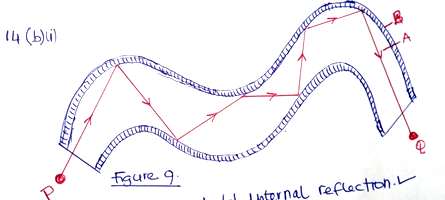INSTRUCTIONS:
- Answer all the questions in the spaces provided.
- Mathematical tables and electronic calculators may be used where necessary.
- What property of light is suggested by the formation of shadows? (1 mk)
- The figure below shows two point objects A and B placed infront of a mirror M.
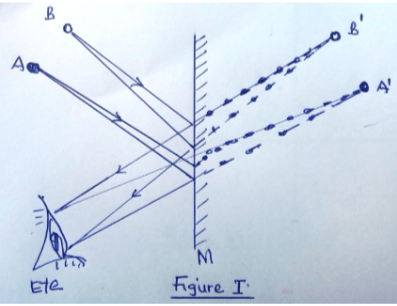
Sketch a ray diagram to show the positions of their images as seen by the eye. (3 mks) - The figure below shows a highly negatively charged rod being brought slowly near the cap of a positively charged leaf electroscope. It is observed that the leaf initially falls and then rises. Explain this observation. (3 mks)
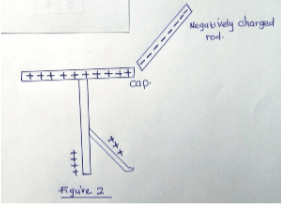
- A current of 0.5A flows in a circuit. Determine the quantity of charge that crosses a point in 4 minutes. (3 mks)
- A car battery requires topping with distilled water occasionary. Explain why this is necessary and why distilled water is used.
(2 mks) - The figure below shows an electrical circuit including three switches, S1, S2, S3 and three identical lamps L1, L2 and L3. A constant potential difference is applied across X and Y.
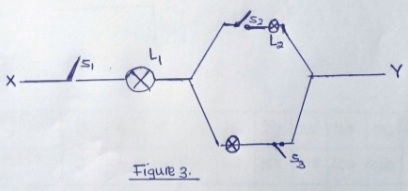
- Other than L1 , state the map that lights when S1 and S2 are closed. (1 mk)
- How does the brightness in L1 in i) above compare with its brightness when all the switches are closed? (1 mk)
- Explain the observation in (ii) above. (1 mk)
- The figure below shows a vertical object O, placed infront of a convex mirror. On the same grid, draw the approximate rays to locate the image formed. (3 mks)
-
- Given a bar magnet, an iron bar and a string;
- Describe a simple experiment to distinguish between a magnet and iron bar. (4 mks)
- State with reasons the observation that would be made in the experiment. (4 mks)
- The figure 5 below shows poles of two magnets closed together.
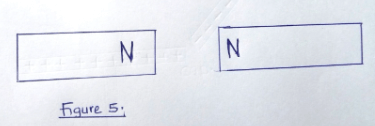
Sketch the magnetic field pattern in the space between the poles. (2 mks)
- Given a bar magnet, an iron bar and a string;
- Figure 6 below shows a ray of light incident on a convex mirror.
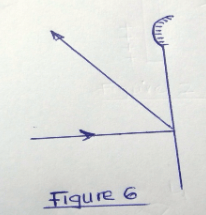
- Using a suitable construction on the same diagram, determine the radius of curvature of the mirror. (2 mks)
- State one application of each of the following:
- Convex mirror (1 mk)
- Parabolic mirror. (1 mk)
-
- In an experiment to determine the strength of an electromagnet, the weight to pins that can be supported by the electromagnet, was recorded against the number of turns. The current was kept constant throughout the experiment.
The table below shows the data obtained.
Figure 7
No. of turns, n, 0 4 8 12 16 20 24 28 32 36 Weight W, of pins X 10-3 (N) 0 4 14 30 58 108 198 264 296 300 - Plot a graph of weight, W, (y-axis) against the number of turns, n (5 mks)
- Use the domain theory to explain the nature of the curve. (3 mks)
- Sketch on the same axes the curve that would be obtained using a higher current. (1 mk)
- Using a labeled diagram, explain the working of a simple relay. (4 mks)
- In an experiment to determine the strength of an electromagnet, the weight to pins that can be supported by the electromagnet, was recorded against the number of turns. The current was kept constant throughout the experiment.
- A girl standing 600m away from a cliff bangs two pieces of wood together and hears an echo 3.5s later. Determine the speed of sound in air at that place. (3 mks)
- The figure below shows the displacement-time graph for a certain wave.

- Determine the frequency of the wave. (3 mks)
-
- What is the difference between longitudinal and transverse waves. (2 mks)
- State two distinctions between the way sound waves and electromagnetic waves are transmitted. (2 mks)
- Calculate the wavelength of the KBC FM radio wave transmitted at a frequency of 95.6 mega Hertz (3 mks)
- Give one example of a transverse wave and one example of longitudinal wave.(2 mks)
- A small object lies at the bottom of a water pond at a depth of 1.2m. Given that the refractive index of water is 1.3, determine the apparent depth of the object (Give your answer to 1 d.p.) (3 mks)
-
- Light travels through glass of refractive index 1.5 with a speed V. Calculate the value of V. (Speed of light in air = 3.0 x 108 m/s). (3 mks)
- The figure below shows a cross-section of an optical fiber made of two types of glass A and B. The refractive of glass is lower than that of A.
- A ray of light enters the optical fibre at P and emerges from Q.
- Sketch the path of the ray through the fibre. (2 mks)
- State the reason why light travels through the fibre as in (i) above. (2 mks)
- A train of mass 200 tonnes starts from rest and ac celebrates uniformly at 0 .5ms-2 .Determine the momentum after moving 100m. (4 mks)
- A higher jumber usually lands on thick soft mattress. Explain how the mattress helps in reducing the force of impact.
- A resultant force F acts on a body of mass M causing an acceleration A1, on the body. When the same force acts on a body of mass 2m, it causes an acceleration A2. Express a2 in terms of a1.
MARKING SCHEME
- What property of light is suggested by the formation of shadows? (1 mk)
- Light travels in a straight line.
- The figure below shows two point objects A and B placed infront of a mirror M.
Sketch a ray diagram to show the positions of their images as seen by the eye. (3 mks) - The figure below shows a highly negatively charged rod being brought slowly near the cap of a positively charged leaf electroscope. It is observed that the leaf initially falls and then rises. Explain this observation. (3 mks)
- The negative charge on the rod initially neutralize the positive charge on the leaf and the plate.
- As the rod is brought nearer, the excess negative charge flows to the leaf and the plate where they repel each other causing the leaf to rise. (3 mks)
- A current of 0.5A flows in a circuit. Determine the quantity of charge that crosses a point in 4 minutes. (3 mks)
Q = 1t + 0.5 x 4 x 60 = 120C - A car battery requires topping with distilled water occasionary. Explain why this is necessary and why distilled water is used. (2 mks)
- Evaporation and cell reaction cause loss of water. Distilled water is used because it does not introduce impurities to the cell. (2 mks)
- The figure below shows an electrical circuit including three switches, S1, S2, S3 and three identical lamps L1, L2 and L3. A constant potential difference is applied across X and Y.
- Other than L1, state the map that lights when S1 and S2 are closed. (1 mk)
- L2
- How does the brightness in L1 in i) above compare with its brightness when all the switches are closed? (1 mk)
- L1 lights brighter
- Explain the observation in (ii) above. (1 mk)
- When the switches are all closed, the total resistance is less.
- Other than L1, state the map that lights when S1 and S2 are closed. (1 mk)
- The figure below shows a vertical object O, placed infront of a convex mirror. On the same grid, draw the approximate rays to locate the image formed. (3 mks)
-
- Given a bar magnet, an iron bar and a string;
- Describe a simple experiment to distinguish between a magnet and iron bar. (4 mks)
- Each bar is suspended at a time using a time using a string. The suspended bar is allowed to rest and its orientation is observed and recorded. This is repeated several times for confirmation. (4 mks)
- State with reasons the observation that would be made in the experiment. (4 mks)
- The bar magnet settles in the N-S direction. Due to its interaction with magnetic field of the earth. The iron bar settles in any direction because it does not have a magnetic field of the earth. The iron bar settles in any direction because it does not have a magnetic field to interact with that of the earth. (4 mks)
- Describe a simple experiment to distinguish between a magnet and iron bar. (4 mks)
- The figure 5 below shows poles of two magnets closed together.
Sketch the magnetic field pattern in the space between the poles. (2 mks)
- Given a bar magnet, an iron bar and a string;
- Figure 6 below shows a ray of light incident on a convex mirror.
- Using a suitable construction on the same diagram, determine the radius of curvature of the mirror. (2 mks)
- State one application of each of the following:
- Convex mirror (1 mk)
- Driving mirror/supermarkets mirror
- Parabolic mirror. (1 mk)
- Solar heater reflector/reflector/torch reflect
- Convex mirror (1 mk)
-
- In an experiment to determine the strength of an electromagnet, the weight to pins that can be supported by the electromagnet, was recorded against the number of turns. The current was kept constant throughout the experiment. The table below shows the data obtained.
- Plot a graph of weight, W, (y-axis) against the number of turns, n (5 mks)
- Graph separate sheet (vertices/labeled with quantities they represent, and SI units, scale must be uniform and consistent, lines of the best fit.
- Use pencil.
- Use the domain theory to explain the nature of the curve. (3 mks)
- Allignment of domain with the field increases as the number of turns is increased.
- After 35 – 36 turns, magnetic saturation is attained and all the domains will have been aligned. (3 mks)
- Sketch on the same axes the curve that would be obtained using a higher current. (1 mk)
- Plot a graph of weight, W, (y-axis) against the number of turns, n (5 mks)
- Using a labeled diagram, explain the working of a simple relay. (4 mks)
- In an experiment to determine the strength of an electromagnet, the weight to pins that can be supported by the electromagnet, was recorded against the number of turns. The current was kept constant throughout the experiment. The table below shows the data obtained.
- A girl standing 600m away from a cliff bangs two pieces of wood together and hears an echo 3.5s later. Determine the speed of sound in air at that place. (3 mks)
Speed = D = 600 X 2 = 342.85m/s
T 3.5 - The figure below shows the displacement-time graph for a certain wave.
- Determine the frequency of the wave. (3 mks)
Periodic time = 3.5 x 10-3S
T = 0.007 F = 1 F = 3 = 428.57hZ
3 T 0.007 -
- What is the difference between longitudinal and transverse waves. (2 mks)
- In longitudinal waves, particles of the transmitting medium vibrate in the direction of the wave while in transverse waves, particles of the transmitting medium vibrate at right angles.
- State two distinctions between the way sound waves and electromagnetic waves are transmitted. (2 mks)
- Transmission of sound waves require a material medium but no material medium is required for electromagnetic waves.
- What is the difference between longitudinal and transverse waves. (2 mks)
- Calculate the wavelength of the KBC FM radio wave transmitted at a frequency of 95.6 mega Hertz (3 mks)
V = fλ = v = 3.0 x 10 = 3.138m
f 95.6 x 10 - Give one example of a transverse wave and one example of longitudinal wave.(2 mks)
- In transverse vibrating particles is perpendicular to motion of the wave while longitudinal waves the vibration of particles is parallel to the motion of the wave.
- Determine the frequency of the wave. (3 mks)
- A small object lies at the bottom of a water pond at a depth of 1.2m. Given that the refractive index of water is 1.3, determine the apparent depth of the object (Give your answer to 1 d.p.) (3 mks)
Apparent = Real depth = 1.2 = 0.9m
Refractive Index 1.3 -
- Light travels through glass of refractive index 1.5 with a speed V. Calculate the value of V. (Speed of light in air = 3.0 x 108 m/s). (3 mks)
Refractive Index = velocity of light in air
velocity of light in glass
1.5 = 3.0 x 108
V
V = 2.0 x 108m/s - The figure below shows a cross-section of an optical fiber made of two types of glass A and B. The refractive of glass is lower than that of A.
A ray of light enters the optical fibre at P and emerges from Q.- Sketch the path of the ray through the fibre. (2 mks)
- State the reason why light travels through the fibre as in (i) above. (2 mks)
- Light undergoes total internal reflection.
- Sketch the path of the ray through the fibre. (2 mks)
- Light travels through glass of refractive index 1.5 with a speed V. Calculate the value of V. (Speed of light in air = 3.0 x 108 m/s). (3 mks)
- A train of mass 200 tonnes starts from rest and accelebrates uniformly at 0 .5ms-2. Determine the momentum after moving 100m. (4 mks)
Momentum = mass x velocity
V2 + U2 = 2as but U = 0
V2 = 2 x 0.5 x 100 = √100
V = 10m/s
Momentum = MV = 200 x 1000 x 10
= 2.0 x 106kgms-1 - A higher jumber usually lands on thick soft mattress. Explain how the mattress helps in reducing the force of impact. (4 mks)
- The mattress increases the stopping time which reduces the rate of change of momentum (impulse)
- A resultant force F acts on a body of mass M causing an acceleration A1, on the body. When the same force acts on a body of mass 2m, it causes an acceleration A2. Express a2 in terms of a1.
F = ma2
= 2ma
a2 = a1
2
Join our whatsapp group for latest updates
Tap Here to Download for 50/-
Get on WhatsApp for 50/-
Download Physics Paper 2 Questions and Answers - Form 3 Term 2 Opener Exams 2023.
Tap Here to Download for 50/-
Get on WhatsApp for 50/-
Why download?
- ✔ To read offline at any time.
- ✔ To Print at your convenience
- ✔ Share Easily with Friends / Students

